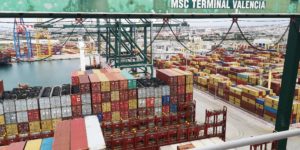
In the first two months of the year, 13.51 million tonnes of goods and 917,054 TEUs have been moved.
February continues with good records thanks to export containers that grew by 13.31%, while the lack of empty containers is confirmed, which fell by 12.2%.
The scarcity of the latter on the market makes it difficult to reserve space in the wagons and the increase in the number of empty containers, and demonstrates the importance of the empty containers for the business network to export its products.
Xina is confirmed as the main partner of Valenciaport in the traffic of containers and goods. The dynamism of areas such as India-Pakistan (+54%), Canada-USA (+45%), West Africa (+40%) or New Zealand (+23%) stands out.
The data corroborate the concentration of cargo/unloading in strategic ports such as Valenciaport, with great connectivity, which require new infrastructures to continue generating employment and wealth.
By sectors, growth in building materials (+27.63%), agri-food (+8.91%), while vehicles fell by 2.28%.
Valenciaport has started the year (January-February) moving 13,514,801 tonnes of goods and 917,054 containers, which represents 5.89% and 3.53%, respectively, more than in the same period of the previous year. This dynamism of Valenciaport is the result of the activity of the companies in its area of influence, which in months still marked by Covid-19, have shown more positive records than in January-February 2020 when the pandemic was not yet affecting the Spanish economy. Thus, once again, the full containers of cargo (exports) were very active with a growth of 13.15% in the first two months of 2021, while those of unloading (imports) fell by 0.63% and those of transit grew by 4.9%.
An increase in traffic despite the decrease in the number of ships arriving at the ports, which are becoming larger and larger or are making more movements per port of call. In fact, in the first two months of the year 114 fewer ships have docked than in the same period of the previous year, something that was already reflected in 2020 when 1,040 fewer ships arrived at the Port of Valencia than in 2019, which represents a decrease of 13.2%. And it is that the global economic situation is producing and accelerating the concentration of the loading/unloading of goods and that there are fewer and fewer “hub” ports such as Valenciaport. Hence the need to continue to invest in new projects and infrastructures to continue to be competitive and generate employment and wealth. In fact, in Valenciaport, where more than 900 companies operate, serving the Spanish business network that use the Port of Valencia to export their products to all corners of the world, 40,000 jobs are generated. A strategic task of Valenciaport, with connections to more than 1,000 ports around the world, as a driving force for the export industry and the logistics community, which is the key to guaranteeing economic recovery and the creation of skilled employment.
February data
If we look only at the month of February, the total of goods handled in Valenciaport amounted to 6,663,989, 2.15% more than in the same month of 2020. In this period, 444,506 TEUs (standard 20-foot container) were moved, an increase of 1.44%, of which the growth of 5.51% in full containers stands out, especially those dedicated to exports, which grew by 13.31%. On the other hand, in February there was a notable drop of 12.22% in the number of vessels, of which those dedicated to transit fell by 27.36%. This indicator highlights the importance of tank container traffic for the export sector, which needs them to be able to load its goods and maintain its export flow. Moreover, the shortage of capacity and empty containers on the market is making it difficult to reserve space on the wagons and is putting upward pressure on the nolis.
Construction materials and agri-foodstuffs, on the rise
In terms of goods traffic by sector, construction materials, with 1,220,738 tonnes, increased by 27.63%, with exports of processed construction materials growing by 36.41%. The agri-food industry has mobilised a total of 1,344,903 tonnes and a growth of 8.91% compared to the first two months of 2020. Also noteworthy is the dynamism of chemical products with 503,198 tonnes and a growth of 7.24%. The vehicles and transport elements sector, with 1,737,146 tonnes, continues to be the industry that moves the most goods through Valenciaport despite registering a decrease of 2.28%. Within this sector, automobiles and their parts fell by 9.7%.
The total traffic of ro-ro goods between January and February was 1,882,502 tonnes with a decrease of 3% compared to 2021. Valenciaport also mobilised a total of 87,816 units of automobiles under the goods regime, 20.17% less.
Dynamism of distant markets
China reaffirmed its position in the first two months of the year as Valenciaport’s main partner, with 1,200,058 tonnes of goods (+7.77%) and 107,804 containers (+7.15%). With regard to TEU traffic, the USA is in second place (+3.74%), followed by Turkey (+2.87%) and in fourth place is India with a growth of 56.27%.
By geographical areas, the main market is the Mediterranean-Black Sea with 3,867,135 tonnes of goods handled and a growth of 4.87%, followed by the Far East with 1,637,639 tonnes (+2.86%). In this section, the dynamism of regions such as West Africa (+39.66%), India-Pakistan-Bangladesh-SkriLanka (+54%), Canada-USA Great Lakes (45.43%), Canada-USA Pacific (+30.91%) and New Zealand (+23.36%) should be highlighted.

